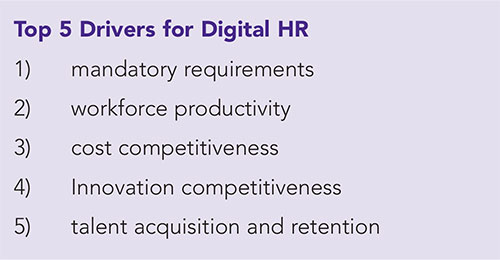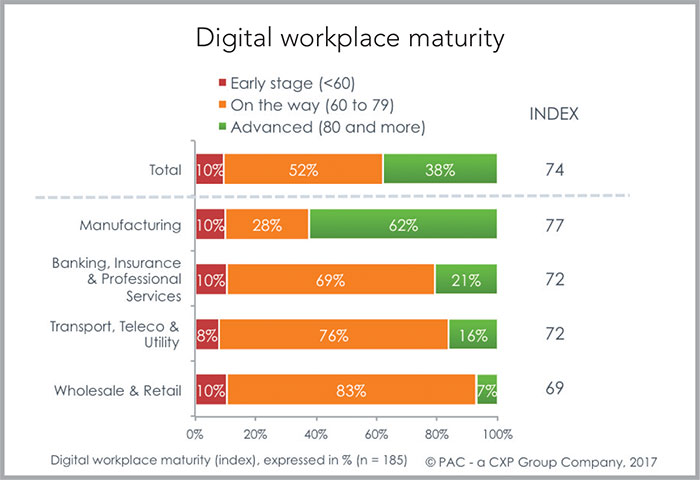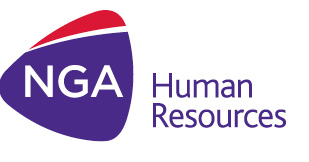Is your business fit for the future of work?


I don’t think I can ever remember a time that has been more challenging for businesses, whether cutting costs or increasing efficiencies or the need to capture new markets due to competitive pressures. Vice President Sales Digital HR of NGA Human Resources, Simon Porter writes.
For the HR community, this is a very interesting time. HR has had to become strategic to help businesses respond to these pressures and adapt. At the end of last year, PAC consulting, supported by NGA HR, carried out a study looking at the Digital Workplace in Europe to establish how fit for the future businesses are.
One of the most interesting findings was that over one quarter of businesses say that an effective digital workplace is critical to their business performance. They say this because those that have made to move can demonstrate clear business benefits associated with such an environment. 75 per cent attribute the introduction of cloud-based tools to increased efficiency.
It’s not just millennials beating down the digital door
The expectation now of most employees, not just millennials, is of a workplace where the functional processes are quick and easy to administer. At home, most of us manage our lives via a mobile device, booking, ordering and banking via fast to access, and increasingly fingerprint or voice secured, apps. We’re connected to the internet of things (IoT).
It would be foolhardy of me to suggest that many, if any business is able to leap full-scale into the digital workplace to match this, but those that are not even making inroads will find themselves at the back of the queue for the future talent pool and in a near impossible position to compete.
BYOD, no longer just an acronym
A colleague, Katy Powell, had a particularly eye opening conversation at a conference recently. Having spoken to people from around the world, the common opinion was that employee experience must be a high priority agenda item.
The most enlightening conversation was with one man involved in recruiting for a global business. He explained the challenge his company had had when recruiting for a software developer. The list of skills and personality traits they were looking for was very specific.
The search took nine months, across six countries. With negotiations complete, the candidate, in his early 20s, asked one last question: ‘I’m assuming it’s OK for me to work on my own device?’
When answered ‘no’, he explained that he’d spent years building the perfect combination of tools to enable him to perform well and in hiring him for his skills, they were also ‘hiring’ his technology.
With no BYOD policy in place they had to let him walk away. ‘BYOD should be a standard policy. I can’t work for a backward thinking business’.
The potential employer had focused on what it wanted, not on a future employees’ expectations.
Technology has empowered the people
The digital evolution has empowered us; giving us access to data on any device, at any time. This puts us in control and as employees, engaged.
A digital workplace, with smart policies, makes it easier to work well and deliver results fast. Digital transformation is not merely how we implement new technology; how we use it is at least as important to our success. There is a great article on this subject in a recent a recent edition of SAP publication, D!gitalist Magazine that goes into detail: http://www.digitalistmag.com/future-of-work/2017/02/20/future-of-iot-mobility-04918930
What’s the blueprint for the digital workplace?
There is no standard for the workplace of the future, but the expectation has been set by the schools our children attend. From the moment children enter the classroom, they use smartboards. By the time they graduate from university, they summit all course work to the cloud.
This is now! Imagine the pace of change. As the children of 2017 start to consider the world of work, their expectations will be far greater than those entering today. Today people ‘want’. Tomorrow they’ll ‘need’. Tomorrow needs to start today.
This might be a generation away, but in terms of investment and change, the transformation process needs to begin. This doesn’t mean huge financial investments.


You can bridge the performance gap
There are extension Apps that bridge the performance gaps between on premise and cloud. XtendHR Apps from NGA HR are built on the SAP Cloud Platform using the SAP Fiori interface so are responsive so they can be used on any device. This ticks the number one employee expectation off the list – mobility, and from their wish list – BYOD. According to Anuj Kumar, SAP’s Director, UKI Banking Industry Strategy and Digital Transformation, you must consider the end point to start your journey. “Digital first has to be the mantra for the HR department, to move from a service provider to a business enabler, always asking the question: how am I help this organisation to make money? This is why the business exists,” he explained at NGA HR’s Future of HR event in Dublin.
We’re not obsolete!
A recent global CEO survey by Harvard, highlighted competitiveness. The ability to attract, retain and train people to be affective is essential, but hard. “We’re facing a global skills shortage and robotics and automation are introducing their challenges. Businesses are having to recruit people with skills they’ve previously not needed, yet employees remain your key to becoming more competitive,” explained Gavin England of Kronos, NGA Human Resources’ global workforce management partner.
Kronos recently sponsored a study into employee engagement, to find out how engaged employees are. The findings were interesting and were published in the The £60 billion Question: Is Employee Engagement the Driver for Business Success?
(https://www.kronos.co.uk/resources/ps60bn-question-employee-engagement-driver-business-success).
When HR managers were asked what their key asset is, those, particularly in manufacturing, said the technology and machinery. Others said brand name. Only 43 per cent of HR managers said people are the top asset!
Perhaps unsurprisingly then, a huge 82 per cent of all managers said their workforce is not as engaged as it could be, yet only a third consider engagement to be important to their business!
It is, therefore, not so surprising that 60 per cent of employees believe leadership teams are focused more on finance than people, irrespective of the fact that it’s people who make the numbers – positive or negative!
The future of work is people
We could conclude here that the future of the workplace is in fact people. People equipped with the best tools, continuous training and the opportunities they need to do well for themselves, and therefore for your business. It’s these digital apps and platforms, and the analytics of big and small data we need to invest in and start bringing to the workforce now.
These are digital and in the cloud due to the arrival of the Fourth Industrial Revolution, as outlined by Davos last year.
Evolution is survival, in this case, business survival.
NGA Human Resources
Damien Peat, Digital HR Strategic Account Director
Mobile: +353 87 988 3633
Email: damien.peat@ngahr.com
Web: www.ngahr.com
Palmerston House, Denzille Lane
Dublin 2






